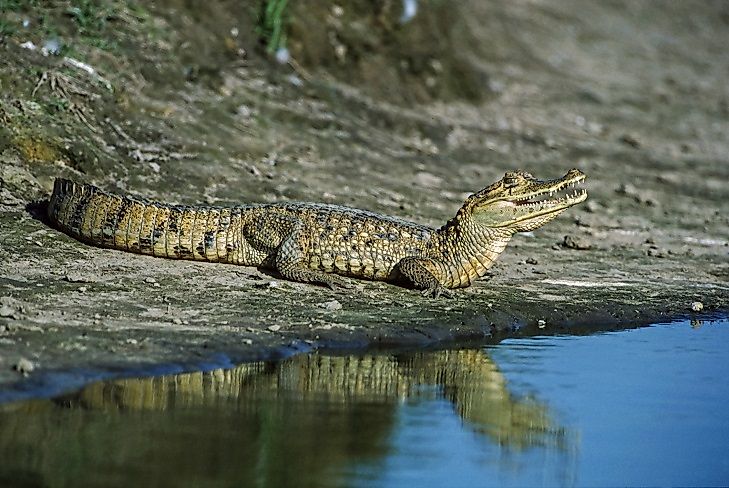Native Reptiles Of Costa Rica

Costa Rica houses a diverse variety of flora and fauna, which includes numerous reptiles, among which are several threatened species. It is estimated that 225 species of reptiles dwell in Costa Rica, with 70 of those species being lizards. Most of these lizards are small, forest-dwelling anoles. There are also giant lizards in Costa Rica, and they include the striped basilisk, the green iguana, and the black iguana. 20 venomous snake species are found in the country. It is also home to a variety of turtles, with 5 of the world’s seven sea turtle species nesting on its beaches.
Spectacled Caiman (Caiman crocodilus)
This reptile, which is also referred to as the white caiman, is found in its habitats in the lowland, wetland, or riverine environments. This crocodilian reptile is present in Central and South America. It has the ability to tolerate salt water and fresh water as well, hence the reason why it is the most common crocodile species. With males reaching 1.8 to 2 meters and females 1.2 to 1.4 meters, the Spectacled Caiman is a small and medium size crocodile, having a body mass of between 7 and 40 kilograms in adults. It has a gray-green coloration. They feed on insects, mollusks, and crustaceans, with larger caiman feeding on fish and water snails. Older caimans can hunt larger prey, for instance, wild pigs. Hunting of these caimans is low owing to the fact that its skin contains osteoderms, disqualifying them for leather production. It is listed on the Convention on International Trade in Endangered Species of Wild Fauna and Flora (CITES) Appendix I and Appendix II.
Helmeted Iguana (Corytophanes cristatus)
This lizard species is endemic to the Americas, ranging from southern Mexico and into South America, with its habitat in the rainforests. It has long limbs, which are the reason for its excellent climbing ability. Its diet consists of spiders, worms, insects, and other spiders. For the sake of thermoregulation when it is basking, the helmeted iguana can change the coloration of its skin from dark to light and light to dark. Its small body can grow up to 34 centimeters. Its coloration has a range from rich brown to gray and olive. Males possess large helmets, by which they are differentiated from their females. They breed and engage in the production of eggs throughout the year. According to the International Union for the Conservation of Nature's (IUCN's) Red List of Threatened Species, it is of low conservation concern, therefore not requiring much additional protection, major management, monitoring, or conservation research action.
White-Lipped Mud Turtle (Kinosternon leucostomum)
The turtle species can be found in Central America and South America, in such countries as Mexico, Costa Rica, Belize, Guatemala, Honduras, Costa Rica, Ecuador, Peru, and other neighboring nations. It has a high and narrow shell and a distinctive whitish lower lip. They prefer humid, swampy habitats, which have slow moving water. Their diet consists of mollusks, insects, dead fish and carrion, and occasionally fruits and other plant matter. According to the IUCN Red List of Threatened Species, the white-lipped mud turtle does not face any specific recorded threats, and as such is not in any great conservational threat necessitating significant conservation efforts.
Rainbow Boa (Epicrates cenchria)
With their unique colorations, the rainbow boas are among the most beautiful snake species to be seen worldwide. They have a vibrant coloration of red and orange, and produce rainbow iridescence, whereby a rainbow effect is given off when the sunlight shines on their scales a phenomenon caused by the presence of light-refracting microscopic ridges on their scales. They are found in South and Central America, in tropical rainforests as well as in drier savanna habitats. They prefer habitats which are near to sources of water. They are mostly nocturnal, being active most of the night. They feed on small mammals and birds. Females give birth to live offspring, having a gestation period of four to five months.
Other Notable Species of Costan Rican Reptiles
Other native reptile species found in Costa Rica include the Black River Turtle (Rhinoclemmys funereal), Carpenter's Anole (Norops carpenter), the Bromeliad Lizard (Anadia ocellata), the Side-Striped Palm Pit Viper (Bothriechis lateralis), the American Crocodile (Crocodylus acutus), and the False Fer-de-Lance (Xenodon rabdocephalus).
Native Reptiles Of Costa Rica
| Native Reptiles of Costa Rica | Scientific Name |
|---|---|
| Spectacled Caiman | Caiman crocodilus |
| Helmeted Iguana | Corytophanes cristatus |
| White-Lipped Mud Turtle | Kinosternon leucostomum |
| Rainbow Boa | Epicrates cenchria |
| Black River Turtle | Rhinoclemmys funerea |
| Carpenter's Anole | Norops carpenteri |
| Bromeliad Lizard | Anadia ocellata |
| Side-Striped Palm Pit Viper | Bothriechis lateralis |
| American Crocodile | Crocodylus acutus |
| False Fer-de-Lance | Xenodon rabdocephalus |











